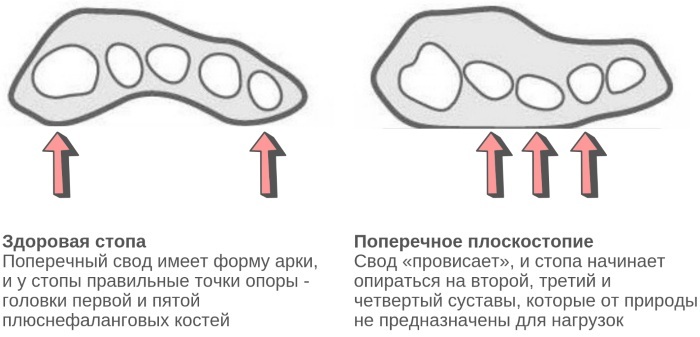Exercise therapy in some situations is one of the ways of treatment, in particular, for the hip joint today, many techniques have been developed aimed at both relieving pain and preventing further destruction of cartilage. At the same time, anyone who wants to do the required exercises at home will not need too much personal time and free space.
Record content:
-
1 With arthrosis (coxarthrosis)
- 1.1 Rules and objectives
- 1.2 Contraindications (restrictions)
-
1.3 The main set of exercises
- 1.3.1 Method B. Dikul
- 1.3.2 Gymnastics M.S. Norbekova
- 1.3.3 Medical complex Bubnovsky
- 1.3.4 Gitta gymnastics
- 1.3.5 Evdokimenko's technique
- 1.3.6 Yoga for coxarthrosis
- 1.3.7 Gymnastics for arthrosis in children
- 1.4 Week schedule
-
2 After operation
- 2.1 Rules and objectives
- 2.2 Contraindications
-
2.3 The main set of exercises
- 2.3.1 The first exercise is for the calf muscle.
- 2.3.2 Second exercise
- 2.3.3 Third exercise
- 2.3.4 Fourth exercise
- 2.3.5 Fifth exercise
- 2.3.6 Sixth exercise
- 2.4 Week schedule
- 3 Video about exercise therapy for the hip joint
With arthrosis (coxarthrosis)
By itself, coxarthrosis is a serious pathology, which consists in the fact that the hip joint, including the bone and cartilaginous composition, is destroyed. Since this is one of the largest joints in a person, it experiences severe stress on itself every day, even during a rest period.
Rules and objectives
Exercise therapy for the hip joint to be performed at home, regardless of when and by whom it was developed, always pursues the following goals:
- Optimize the blood supply to the affected area.
- Strengthen the muscles and ligaments located near the joint as much as possible in order to improve protection against injury and various injuries.
- Reduce body weight, which helps to reduce stress on the joint.
- To revive the clarity and confidence of the movements performed by the joint.
- Relieve spasm and relieve pain.
- Eliminate the likelihood of disease progression and the occurrence of any complications.
Physical therapy also obliges a person to adhere to several simple, but still important rules:
- Avoid sudden movements of the legs.
- Completely eliminate swings with a wide amplitude, axial load and weights.
- Exercises should be performed either before meals or after meals in 1.5-2 hours.
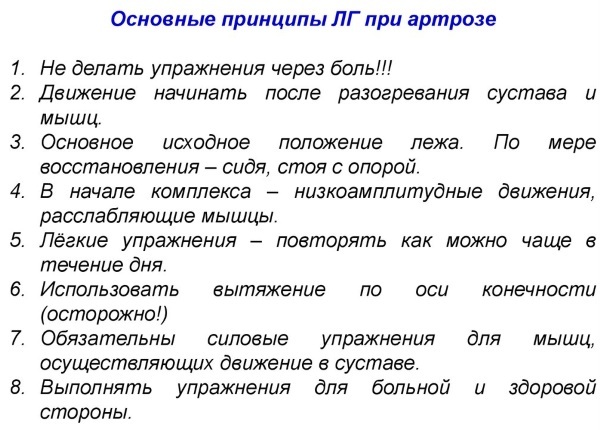
These rules are relevant for both older people and young people, including children.
Contraindications (restrictions)
It is strictly not allowed to perform any exercises with coxarthrosis in such situations:
- if pain is present;
- with high blood pressure;
- in the presence of an inguinal hernia;
- after surgery until complete rehabilitation;
- if there are any oncological diseases;
- on critical days in the fairer sex.
The principles of performing exercise therapy for coxarthrosis:
- Exercise daily and regularly to keep the joint nourished and stressed.
- The starting position depends solely on the condition of the patient. If a person suffers from the 1st or 2nd degree of arthrosis, then you can perform active exercises while standing or sitting. In the case of a severe form of the disease or in the postoperative period, exercise therapy is recommended to be performed only lying down.
- Adjust the load using repetitions to stay comfortable.
- If pain occurs, you must immediately stop gymnastics.
- Breathing needs to be controlled, but it should be even, not intermittent.
- At the end of each set of exercises, you should raise your arms up, lowering them in a smooth manner down to improve breathing.
The main set of exercises
Exercise therapy for the hip joint for performing at home has been developed by several well-known authors; some of them have suffered serious injuries themselves. Among the most popular therapeutic complexes, one should highlight the methods of Dikul, Pilyuiko, and Norbekov.
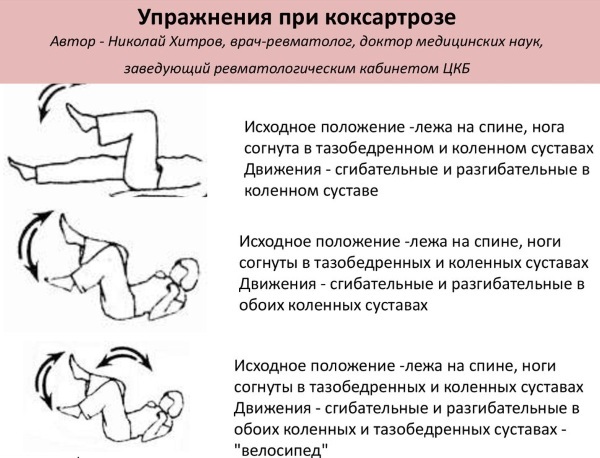

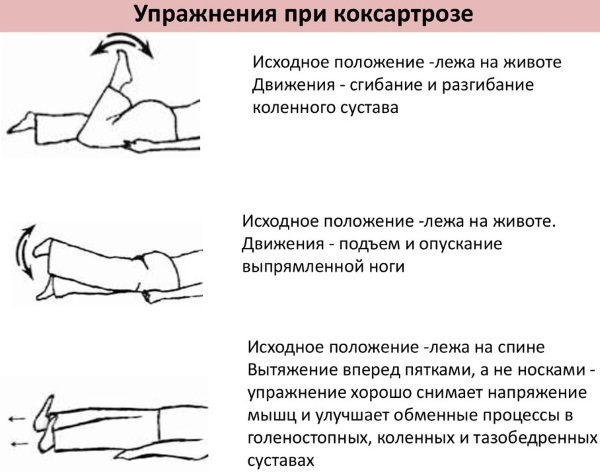
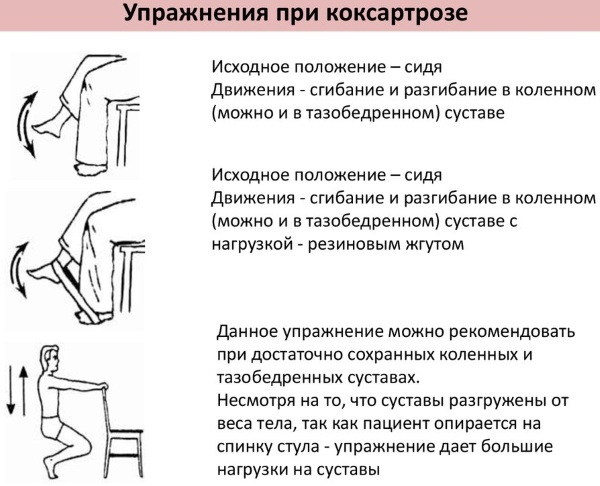
Each of the complexes is aimed at:
- restoration and improvement of muscle tone;
- improving metabolism in the joints;
- getting rid of pain;
- improved blood flow;
- removal of inflammation and edema;
- additional nutrition of cartilaginous tissues.
At the earliest stages of the onset of coxarthrosis, when there are no pains, in addition to exercise therapy, sports are recommended:
- jogging;
- fast (Scandinavian) walking;
- training on simulators;
- bicycle riding;
- swimming.
Method B. Dikul
The essence of this gymnastics is to establish natural blood flow in all extremities, remove swelling and spasms.
The technique consists of three stages:
- Preparatory. During this stage, pain is relieved and muscle tone is increased. Exercises should be performed with a large amplitude, without various additional loads. The complex is recommended to be carried out 3 times a week for 4 months.
- Power - an increase in the strength load on the muscles. Gymnastics already needs to be done 4 times a week, and the duration of this stage is 6 months.
- Fastening. Endurance increases, the normal potential of the body is created, which contributes to the return to the usual life.
Gymnastics M.S. Norbekova
According to the author of the health-improving method of treating joints and the whole organism as a whole, Norbekov, the lion's a share in a person's recovery is played by his psychoemotional state, and then the charger.
The main tasks of the complex include: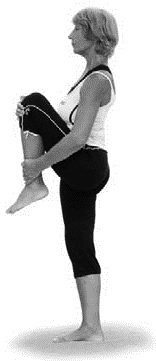
- Personal development of a person and an increase in his self-esteem.
- Formation of a positive attitude towards life.
- Increasing social and labor activity.
A set of exercises for joint gymnastics:
- In a standing position, pull the toe of one leg down and then turn towards you.
- Raise one leg, bent at the knee, and turn the foot inward, then return it back. For the other leg, do the same.
- Standing with your legs together, bend forward and straighten.
- Standing shoulder-width apart, raise one limb, bend at the knee joint, and take it to the side. Work with both legs.
Medical complex Bubnovsky
Dr. Bubnovsky, after suffering a serious injury, thought about creating a special exercise technique that would allow him to get rid of arthrosis. They can be performed on simulators developed by the author himself, as well as without them at home.
In addition to physical activity, special emphasis is placed on correct, even breathing, which allows you to saturate the body with oxygen and get rid of excess carbon dioxide. The load should be increased gradually so as not to overload the joint. The complex is suitable for all ages.
Exercises for legs lying on your back:
- Bend at the knees and take turns pulling to the chest, wrapping your arms around. Hold for a few seconds and return to the starting position (PI).
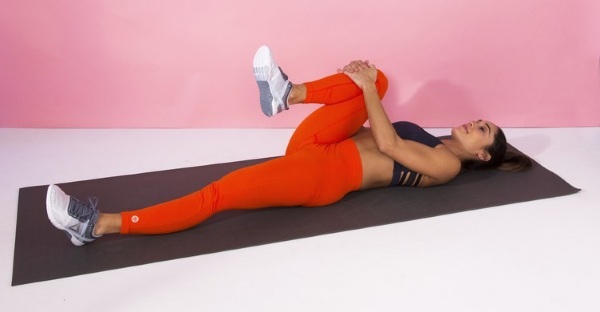
- Raise it alternately to a height of 30 cm and hold it in the air for a few seconds.
- Spread your knees in different directions.
- Imagining that you need to push something heavy away from you, stretch your legs alternately forward. The toe should be directed towards itself.
- Bend your bent legs with your knees inward, without moving your pelvis.
- Raise your head and limbs at the same time. The ascent is done with inhalation, and the lowering is done with the exhalation.
Standing exercises involve swinging your legs back and forth, and then to the sides. There are also exercises while sitting on a chair. You should slowly lean forward, trying to reach your feet with your fingers. After classes on this Bubnovsky technique, the blood supply to the joints improves and the pain syndrome goes away for some time.
However, this gymnastics is contraindicated for people suffering from pulmonary insufficiency and infectious diseases. It is also not recommended to do exercises for cardiac pathology and for persons suffering from chronic gastrointestinal diseases.
Gitta gymnastics
Exercise therapy for the hip joint for performing at home, developed by V.D. Gitt, is also an effective gymnastics for coxarthrosis. It is especially popular among the elderly, since it is quite simple to perform and does not require much effort.
Initially, two exercises are performed in a horizontal position:
- It is necessary to turn on your stomach and move each hip in turn, as if rolling from side to side. This stimulates blood flow to the affected areas and improves bowel function.
- Next, you should turn on your back, spread your legs wide to the sides and turn them to the outside.
The following exercises are recommended by Gitt (sitting):
- The feet are firmly fixed on the floor and the knees are spaced apart. You should bring them together and then spread them in different directions.
- Raise your feet to toe, separating the heels from the floor.
Despite the simplicity of V.D. Gitta, it is considered no less effective than other medical complexes.
Evdokimenko's technique
The author of this technique advises performing exercises with an equal distribution of the load on both legs, focusing on the muscles of the trouble and the pelvis. Each exercise must be performed 10 times.
- Alternately raise straight legs up, holding them in the air for 4-5 seconds, and then lower them back. The pelvis must not be torn off the floor.

- Lying on your stomach, raise your straight legs to a height of about 15 cm from the floor level and hold. Then spread apart, bring together and lower.
- Sitting on your side, bend one leg at the knee, and raise the other 45 degrees and hold for less than a minute. Turn over on the other side and do the same with the other leg.
This set of exercises can be adopted by people of all ages, taking into account their physical condition and the presence of other diseases.
Yoga for coxarthrosis
Some yoga practices also help improve the condition of people with arthrosis of the hip joint. As a rule, yoga is characterized by static postures and smooth movements.
There are two basic flowing exercises:
- Sit up straight and straighten your limbs. Bend one leg and gently put it on one side, while trying to reach with your toes to the inner thigh. Hold in this position for 4-5 seconds, then perform similar actions for the second leg.
- Spread straight legs to the sides and bend forward to reach your feet with your fingers. The main thing is to do everything smoothly and prevent the appearance of pain.
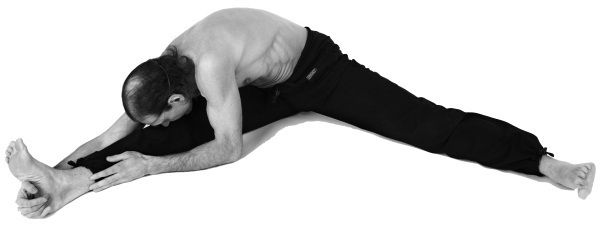
- Raise the limbs in turn and hold them for a few seconds, without straining the joint too much, but relying on strengthening the muscles.
Gymnastics for arthrosis in children
Slightly more vigorous exercise is recommended for young adults and children than older adults. If this is not a severe degree of the disease, then it is recommended to carry out gymnastics in a standing and sitting position.
To them you can add daily walks in the fresh air, and if the climate does not allow, then at home around the room. You should observe uniform breathing, and to restore it, take deep breaths with raising your arms up after each exercise.
Doctors also recommend that children be sure to perform physical therapy under the supervision of parents or relatives who monitor the correctness of movements. Posture, especially in adolescents, is often impaired, therefore, when performing exercise therapy, it is imperative to keep the correct posture.
Some exercises are prohibited for children, namely:
- excessive force loads on the spine and joints;
- sharp swinging limbs, which can lead to injury;
- too long gymnastics, which provokes a negative attitude.
It is not recommended to openly force children to engage in exercise therapy, so as not to cause the opposite effect in the child. To achieve a positive result, an extremely positive attitude is required. Rhythmic music, to which morning exercises are usually done, can come to the rescue.
Week schedule
To achieve a positive result in the treatment of hip joints, periodicity and consistency in the implementation of therapeutic and preventive physical education is necessary. Many authors of special gymnastics offer their own schedule or recommend making a personal schedule of classes for the week in order to achieve maximum results.
| Day of week | Starting position | Gymnastic complexes |
| Monday | Lying on your back |
|
| Tuesday | Lying on your back |
|
| Wednesday | Lying on its side | Raising one leg to a height, with the other bent. It is performed alternately for both legs. |
| Thursday | Lying on my stomach |
|
| Friday | Sitting on a chair |
|
| Saturday | Sitting on the rug | Bends forward to toes with straight legs |
| Sunday | Standing | Moderate walking with pauses |
After operation
Exercise therapy for the hip joint for performing at home is especially difficult in the first days after surgery. Typically, a pillow is placed between the legs of a person in order to control leg extension and provide maximum comfort. The leg, on which the operation was performed, fits in the retracted position, and this must be monitored.
Rules and objectives
The basic rules that should be followed by persons who have undergone surgery for coxarthrosis:
- Sleeping is allowed exclusively on the back.
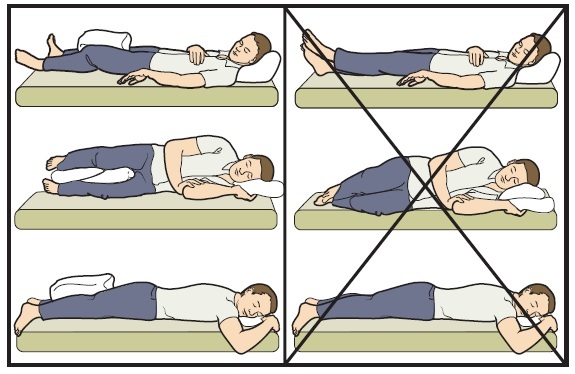
- You should only turn to the affected side after a week or two. It is better to just lie or sleep on a healthy side about 6 weeks after the surgery.
- In the early days, sharp leg swings should be avoided in order to exclude flexion in the joints by more than 90 °, as well as to avoid rotations in the operated joint.
- When sitting and using the toilet, care must be taken that there is no strong flexion.
- It is forbidden to squat and cross-legged anywhere.
The main goal of therapeutic and prophylactic physical education after procedures is to restore blood flow in the operated limb. This is important due to the fact that in the shortest possible time it is required to prevent swelling and blood stasis, to speed up the wound healing process.
The second goal of exercise therapy is to restore the normal functioning of the muscular system and the usual range of motion in the joints. It should be remembered that the exercises for the first 3-4 weeks after the operation are performed while lying in bed.
Contraindications
When performing gymnastic complexes, it is not allowed:
- To carry out sharp movements, but on the contrary - soft and smooth, in order to avoid dislocations.
- Excessive muscle tension.
- Before getting out of bed, it is recommended to bandage your legs with special elastic bandages (women can wear elastic stockings) in order to avoid venous diseases.
- Correct breathing during exercise should not be neglected - inhalation usually coincides with muscle tension, and exhalation with a relaxed state.
Exercises that are contraindicated:
- sharp flexion and extension of the limbs;
- long jogging and brisk walks;
- increased torso flexion;
- twisting legs;
- squats with any amplitude.
The main set of exercises
Exercise therapy for the hip joint in the postoperative period should initially be performed at home in your bed. It is necessary to lie flat on a hard surface so that the body line is parallel to the floor.
The first exercise is for the calf muscle.
You should deflect your feet with low tension towards yourself and away from yourself. You need to perform such gymnastics with both legs at the same time, 6-7 times within one hour. Movements can begin immediately after recovering from the effects of anesthesia.
You need to perform such gymnastics with both legs at the same time, 6-7 times within one hour. Movements can begin immediately after recovering from the effects of anesthesia.
Second exercise
The affected leg should be taken a little to the side and back, while not lifting the point of the hips from the bed.
Third exercise
It is necessary to have a healthy leg bent at the knee joint, and leaning on the heel, slightly raise the pelvis. The operated limb must remain in place.
Fourth exercise
Turn both knees and feet inward as much as possible and return back to the starting position. Exercise is effective in that it restores blood circulation, strengthens the muscles of the legs.
Fifth exercise
Directing the toe up, bend the operated limb by rubbing the heel over the surface. In the same way, return the leg to its original position.
Sixth exercise
It is necessary to raise the affected leg, slightly bent at the knee, and hold it for a few seconds, then lower it back.
Week schedule
The starting position for all exercises during the first week after hip surgery is lying on a flat surface.
| Day of week | A set of exercises |
| Monday | Turning the feet in and out |
| Tuesday | Abduction and return to the original position of the affected leg |
| Wednesday | Warm up the healthy leg - bending the knee and raising the pelvis. |
| Thursday | Flexion at the knee of the affected leg |
| Friday | Raising the operated leg |
| Saturday | Raising and lowering both legs to a low height |
| Sunday | Raising and slightly flexing the operated leg, returning to the supine position. |
The most important principles of performing exercise therapy for the hip joint after a successful operation at home are smoothness and slowness.
Smooth and regular action promotes early recovery and eliminates pain. You also need regularity in the performance of sets of exercises so that the joints are constantly nourished, and the increased blood circulation ensures their normal work.
Video about exercise therapy for the hip joint
Gymnastics for the hip joints:



